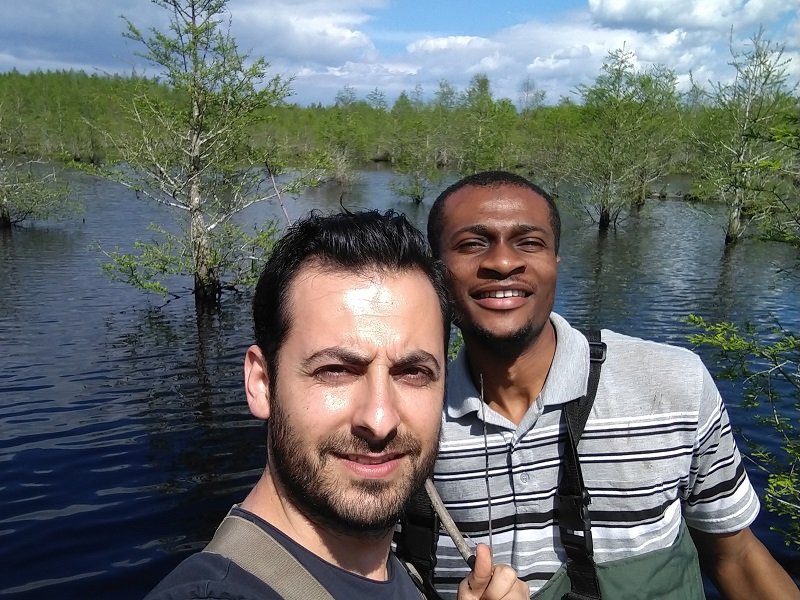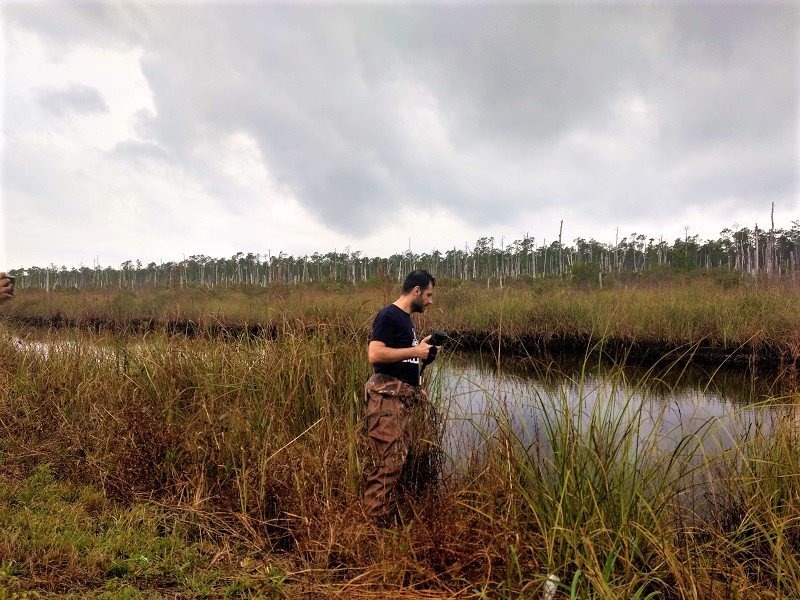
By Maya Hoon/N.C. Water Resources Research Institute
As sea levels continue to rise with each passing year, researchers focus their attention on how coastal wetlands may be impacted by the change. While there is an abundance of research on the impacts of sea level rise on various factors of the coast, few studies have addressed how rising sea levels may affect mercury deposits in the coastal region.
One researcher tackling the question of mercury’s impacts on freshwater coastal wetlands is Yener Ulus, a 4th year Ph.D. student in Environmental Health Sciences at University of North Carolina at Greensboro (UNCG). Using his joint North Carolina Sea Grant – Water Resources Research Institute (WRRI) graduate research fellowship award, he formulates his questions to investigate how mercury changes from its inorganic form, which is less likely to transfer into animals or people, to a more toxic methylated form, when saltwater begins invading freshwater wetlands.
“We already know there is mercury pollution,” Ulus states. “But, we don’t know what this perturbation would look like with sea level rise, hurricanes, storm surges and floods.”
Mercury is present in almost every waterbody and is one of the most common pollutants in North Carolina’s freshwater fish. It has the potential to threaten the health of people consuming those fish. However, the form of mercury dictates the level of threat that this pollutant poses for human and ecosystem health. As saltwater invades freshwater wetlands, it can carry abundant sulfate into these systems, which sets off a chain reaction in the wetland.
“There is sulfate-reducing bacteria that uses the sulfate,” Ulus explains. “As a byproduct it converts inorganic mercury into organic mercury – which we call methylmercury, the most toxic form. This methylmercury is in the water, sediment, the plankton, small insects, fish and eventually humans who eat the fish.”

Field Work
When he gathers samples to study, Ulus must drive five hours with his crew from Greensboro to his wetland study sites in Dare and Tyrrell Counties. He dedicates up to five hours to collecting sediment, water and biota samples, then makes the five-hour drive back to his lab. Ulus does not hesitate to make the long trip even in the toughest weather situations. When Hurricane Dorian made its way to North Carolina’s coasts, he visited his sites for samples prior to the storm surge, even while the local towns were evacuating.
“The results are amazing,” Ulus says. “One week after the hurricane passed, we went back to collect samples. So, basically that gave me a chance to see how methylmercury will vary when you have excessive amounts of sea water intrusion from storm surge.” With the collected samples, Ulus and his crew managed to observe there was, indeed, an increase in methylmercury production.
Having a clearer picture of the methylmercury levels in the water and sediment of his wetland sites, Ulus is beginning to question how these levels are reflected into the food chain. He is seeking to sample more biota from his wetland sites to understand how methylmercury bioaccumulates into wetland organisms and how it is transferred through the food web. Ulus thinks understanding how methylmercury moves through the food web is key to understanding how human communities may be impacted by the toxin.
“We should provide a good environment for any wildlife – for anything as a whole. We should not just think about ourselves.”
Research Extension
Growing up in Arsuz, Turkey, a small green town near the Mediterranean Sea that relies on fishing and farming, Ulus understands the value of nature and realizes that it must be protected. Ulus states, “I wanted to be the person who saves the environment while also being a good influence to those around me”. This mentality is driving Ulus’ passion for his Ph.D. work and is motivating him to extend his findings outside of his lab.
Ulus extends his research outside of his lab and field site to make sure citizens are aware of mercury pollution in coastal areas. As a volunteer with UNCG’s Science Everywhere program, he teaches students from kindergarten up to high school about mercury as a pollutant.
In Tyrrell County, one of the poorest counties in North Carolina and the location of one of Ulus’ sites, Ulus finds that “many people actually don’t know about mercury…. So, one of my purposes is to explain what’s going on in their own community about mercury pollution, because most of them have no idea about that.” He has been in contact with the town manager at Columbus, N.C. to speak with the mayor about mercury and his research to help communities in the area understand mercury pollution in general.
Outside of the U.S., Ulus presented his research to experts in his field at the 14th International Conference on Mercury as a Global Pollutant in Poland. He even presented and discussed his research with government representatives and communities in his home country, Turkey.
While protecting human health is important, Ulus emphasizes that we have special areas in North Carolina that we should protect to preserve the wildlife and natural beauty.
“We should provide a good environment for any wildlife — for anything as a whole.” Ulus says, “We should not just think about ourselves. When I go [to my wetland sites] I see the blue herons, they are flying. Or I see the bears! This is our treasure, you know? We should keep them clean. We should not let them vanish.”

This story was originally published on the N.C. Water Resources Research Institute website.
